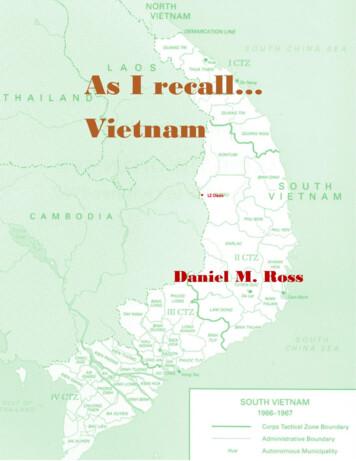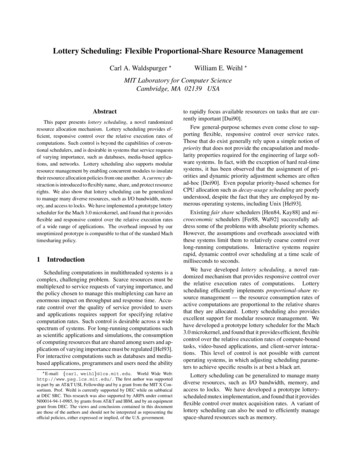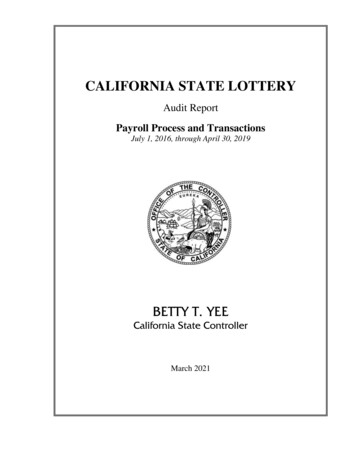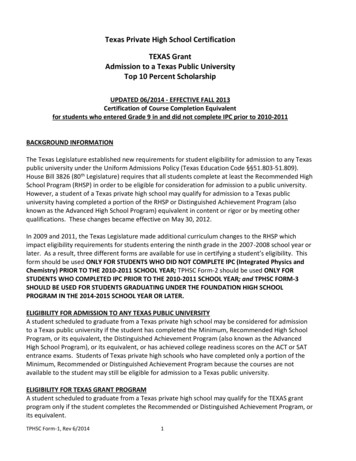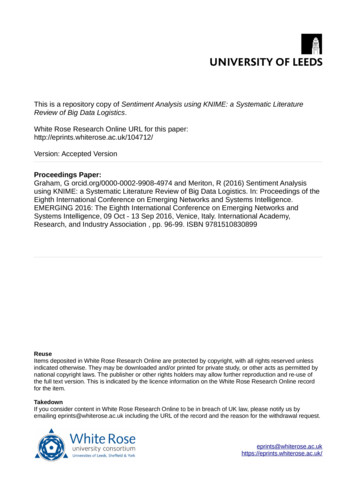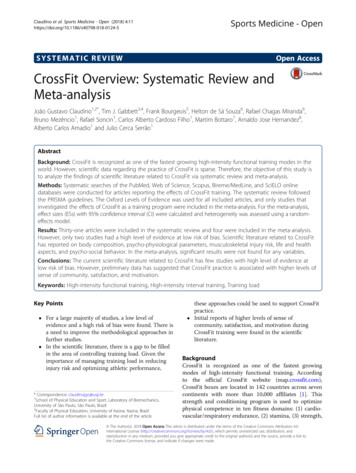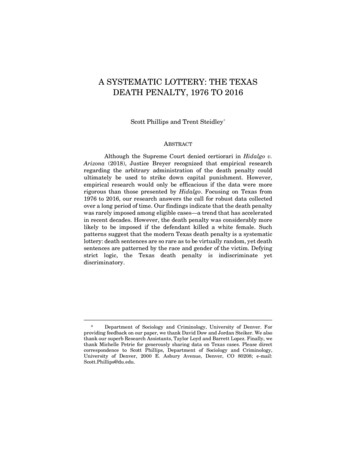
Transcription
A SYSTEMATIC LOTTERY: THE TEXASDEATH PENALTY, 1976 TO 2016Scott Phillips and Trent Steidley *ABSTRACTAlthough the Supreme Court denied certiorari in Hidalgo v.Arizona (2018), Justice Breyer recognized that empirical researchregarding the arbitrary administration of the death penalty couldultimately be used to strike down capital punishment. However,empirical research would only be efficacious if the data were morerigorous than those presented by Hidalgo. Focusing on Texas from1976 to 2016, our research answers the call for robust data collectedover a long period of time. Our findings indicate that the death penaltywas rarely imposed among eligible cases—a trend that has acceleratedin recent decades. However, the death penalty was considerably morelikely to be imposed if the defendant killed a white female. Suchpatterns suggest that the modern Texas death penalty is a systematiclottery: death sentences are so rare as to be virtually random, yet deathsentences are patterned by the race and gender of the victim. Defyingstrict logic, the Texas death penalty is indiscriminate yetdiscriminatory.*Department of Sociology and Criminology, University of Denver. Forproviding feedback on our paper, we thank David Dow and Jordan Steiker. We alsothank our superb Research Assistants, Taylor Loyd and Barrett Lopez. Finally, wethank Michelle Petrie for generously sharing data on Texas cases. Please directcorrespondence to Scott Phillips, Department of Sociology and Criminology,University of Denver, 2000 E. Asbury Avenue, Denver, CO 80208; e-mail:Scott.Phillips@du.edu.
1044COLUMBIA HUMAN RIGHTS LAW REVIEW[51.3TABLE OF CONTENTSIntroduction . 1045I. The Meaning of Arbitrariness . 1046II. Data and Findings . 1051A. The Overall Death Sentence Rate in Texas, 1976 to 2016 . 10511. Components of Death Eligibility . 10532. Potential Sources of Undercounting Death-EligibleDefendants . Defendants . 10554. Calculating the Overall Death Sentence Rate . 1057B. Temporal Trend: Increasing Arbitrariness . 1059C. The Nexus Between Discretion and Discrimination . 1062Conclusion . 1065Appendices . 1068
2020]The Texas Death Penalty, 1976 to 20161045INTRODUCTIONThe notion of the “American death penalty” is a misnomer. TheUnited States currently has thirty separate death penalty systems:twenty-eight state systems, the federal system, and the militarysystem. 1 Moreover, state authority is largely devolved to counties—thelocal district attorney decides whether to seek the death penalty, andlocal jurors decide whether to impose a death sentence. 2 Importantly,decentralization has produced geographical concentration, with asmall number of states and counties generating a vastlydisproportionate share of death sentences and executions. 3Among death penalty systems, Texas stands alone. During themodern era of the death penalty, 4 the Lone Star State accounts for 569of the 1512 executions in the United States. 5 The next sixstates—Virginia, Oklahoma, Florida, Missouri, Georgia, andAlabama—account for 554 executions. 6 Not surprisingly, four of thefive counties with the most executions are in Texas: Harris County(Houston), Dallas County (Dallas), Tarrant County (Forth Worth), andBexar County (San Antonio). 7 Texas is truly the epicenter of capitalpunishment.Despite its singular status, key questions regarding theadministration of the Texas death penalty remain unanswered. 81.See State by State, DEATH PENALTY INFO. CTR., o/state-by-state [https://perma.cc/N7FG-NBVJ].2.Frank R. Baumgartner et al., The Geographic Distribution of U.S.Executions, 11 DUKE J. CONST. L. & PUB. POL’Y 1, 28–29 (2016) [hereinafterBaumgartner et al., Geographic Distribution].3.Lee Kovarsky, Muscle Memory and the Local Concentration of CapitalPunishment, 66 DUKE L.J. 259 (2016); Baumgartner et al., Geographic Distribution,supra note 2.4.The Supreme Court ruled the death penalty unconstitutional in 1972 inFurman v. Georgia, 408 U.S. 238 (1972). But the Court reinstated the death penaltyin 1976 in Gregg v. Georgia, 428 U.S. 153 (1976), marking the beginning of themodern era of capital punishment.5.Execution Database, DEATH PENALTY INFO. CTR., database [https://perma.cc/N7FG-NBVJ] (coveringthe period from 1976 to 2019).6.Executions by State and Region Since 1976, DEATH PENALTY INFO. gion-since-1976 [https://perma.cc/8VAZ-8L3R] (coveringthe period from 1976 to 2019).7.Kovarsky, supra note 3, at 280 tbl.7.8.The current research examines two forms of arbitrariness in theadministration of the Texas death penalty: numerical and social. We are aware of
1046COLUMBIA HUMAN RIGHTS LAW REVIEW[51.3Focusing on the period from 1976 to 2016, the current Article presentsoriginal quantitative research to answer two questions: Is the Texasdeath penalty imposed arbitrarily? If so, has the degree of arbitrarinesschanged over time? Before answering such questions, we consider themeaning of arbitrariness.I. THE MEANING OF ARBITRARINESSIn Furman v. Georgia, 9 the United States Supreme Court ruledin a landmark 5–4 decision that the death penalty was imposedarbitrarily and thus violated the Eighth and FourteenthAmendments. 10 Used as a term of art, arbitrariness means that deathsentences are not based on the culpability of the defendant. Instead,death sentences are imposed randomly or are patterned byimpermissible factors such as race and socioeconomic status. 11In their Furman concurrences, Justices Stewart, Brennan, andWhite defined arbitrariness through a numerical lens: the percentageof death-eligible defendants who were actually sentenced to death wasso negligible that the ultimate sanction had become random andcapricious. Using a lightning metaphor, Justice Stewart noted:These death sentences are cruel and unusual in thesame way that being struck by lightning is cruel andunusual. For, of all the people convicted of rapes andmurders in 1967 and 1968, many just as reprehensibleas these, the petitioners are among a capriciouslyselected random handful upon whom the sentence ofdeath has in fact been imposed. 12Justice Brennan chose the metaphor of a lottery: “When thepunishment of death is inflicted in a trivial number of the cases inwhich it is legally available, the conclusion is virtually inescapable thatit is being inflicted arbitrarily. Indeed, it smacks of little more than aone prior research project that examined both issues in Texas. Scott Phillips &Alena Simon, Is the Modern American Death Penalty a Fatal Lottery? Texas as aConservative Test, 3 LAWS 85, 100 (2014). The current research extends the work ofPhillips and Simon by examining a much longer period of Texas history andinvestigating changes over time.9.408 U.S. 238 (1972).10.Despite being a plurality opinion, Furman remains binding precedent.Sam Kamin & Justin Marceau, Waking the Furman Giant, 48 U.C. DAVIS L. REV.981, 988 (2015).11.See Scott Phillips & Justin Marceau, Whom the State Kills, 55 HARV.C.R.-C.L. L. REV. (forthcoming 2020).12.Furman, 408 U.S. at 309–10 (Stewart, J., concurring).
2020]The Texas Death Penalty, 1976 to 20161047lottery system.” 13 Justice White explained that “there is no meaningfulbasis for distinguishing the few cases in which [death] is imposed fromthe many cases in which it is not.” 14How rare was the imposition of death among eligible cases?Steven Shatz explains: “When the Court decided in Furman that thedeath penalty, as then administered by the states, created too great arisk of arbitrariness, it was the Justices’ understanding that only15%–20% of death-eligible murderers were sentenced to death.” 15Although the Court did not specify a death sentence rate that wouldpass constitutional muster, a death sentence rate of less than 20%clearly would not. 16Justices Douglas and Marshall defined arbitrariness in adifferent way from Justices Stewart, Brennan, and White. Viewingarbitrariness through a social lens, Douglas noted:A law that stated that anyone making more than 50,000 would be exempt from the death penalty wouldplainly fall, as would a law that in terms said thatblacks, those who never went beyond the fifth grade inschool, those who made less than 3,000 a year, orthose who were unpopular or unstable should be theonly people executed. A law which in the overall viewreaches that result in practice has no more sanctitythan a law which in terms provides the same. 17Justice Marshall concurred:Regarding discrimination, it has been said that ‘[i]t isusually the poor, the illiterate, the underprivileged, themember of the minority group—the man who, becausehe is without means, and is defended by a courtappointed attorney—who becomes society’s sacrificiallamb. . . .’ Indeed, a look at the bare statistics13.Id. at 293 (Brennan, J., concurring).14.Id. at 313 (White, J., concurring).15 .Steven F. Shatz, The Eighth Amendment, the Death Penalty, andOrdinary Robbery-Burglary Murderers: A California Case Study, 59 FLA. L. REV.719, 745–46 (2007).16.Steven F. Shatz & Nina Rivkind, The California Death Penalty Scheme:Requiem for Furman?, 72 N.Y.U. L. REV. 1283, 1289 (1997).17.Furman, 408 U.S. at 256–57 (Douglas, J., concurring) (internal citationomitted).
1048COLUMBIA HUMAN RIGHTS LAW REVIEW[51.3regarding executions is enough to betray much of thediscrimination. 18Furman invalidated existing statutes and commuted thesentences of more than 600 death row inmates to life in prison.However, the decision did not mark the end of capital punishment. Infact, thirty-five states restored the death penalty between 1972 and1976. 19 Some states attempted to eliminate arbitrariness by makingthe death penalty mandatory for certain crimes. 20 Other states adoptedguided discretion, an approach that narrowed the range of deatheligible offenses, bifurcated the guilt and punishment stages of a case(to provide jurors with more evidence regarding aggravation andmitigation during the punishment phase), and guaranteed automaticappellate review. 21 In Woodson v. North Carolina 22 and the companioncase of Roberts v. Louisiana, 23 the Court struck down mandatory deathstatutes, concluding that the protection of human dignity requiredindividual consideration of each case. However, the Court upheldguided discretion statutes in Gregg v. Georgia 24 and the companioncases of Proffitt v. Florida 25 and Jurek v. Texas. 26In Gregg, the Court assumed that guided discretion would curethe arbitrariness identified in Furman. The Court’s logic wasstraightforward: if legislatively-defined statutory aggravators wereused to narrow the pool of death-eligible defendants to the “the worstof the worst” then most would be sentenced to death; if most deatheligible defendants were sentenced to death then arbitrariness—randomand patterned—would disappear. 27 Justice White articulated the Court’sprediction in Gregg:18.Id. at 364 (Marshall, J., concurring) (quoting Hearings on S. 1760 beforethe Subcommittee on Criminal Laws and Procedures of the Senate Committee on theJudiciary, 90th Cong. 11 n.80 (1968)) (alterations in original).19 .See RAYMOND PATERNOSTER, ROBERT BRAME, & SARAH BACON, THEDEATH PENALTY: AMERICA’S EXPERIENCE WITH CAPITAL PUNISHMENT 89–108(2008) (describing examples of post-Furman death penalty statutes).20.See id.21.See id.22.428 U.S. 280, 303–04 (1976).23.431 U.S. 633, 637–38 (1976).24.428 U.S. 153, 206–07 (1976).25.428 U.S. 242, 259–60 (1976).26.428 U.S. 262, 276 (1976).27.DAVID C. BALDUS, GEORGE WOODWORTH & CHARLES A. PULASKI, JR.,EQUAL JUSTICE AND THE DEATH PENALTY: A LEGAL AND EMPIRICAL ANALYSIS 31(1990).
2020]The Texas Death Penalty, 1976 to 20161049As the types of murders for which the death penaltymay be imposed become more narrowly defined and arelimited to those which are particularly serious or forwhich the death penalty is peculiarly appropriate asthey are in Georgia by reason of the aggravatingcircumstance requirement, it becomes reasonable toexpect that juries—even given discretion not to imposethe death penalty—will impose the death penalty in asubstantial portion of the cases so defined. If they do,it can no longer be said that the penalty is beingimposed wantonly and freakishly or so infrequentlythat it loses its usefulness as a sentencing device.There is, therefore, reason to expect that Georgia’scurrent system would escape the infirmities whichinvalidated its previous system under Furman. 28Empirical research suggests that guided discretion did noteliminate “lightning strikes” and “lotteries”: past studies determinedthe death sentence rate to be 11% in California, 29 4% in Connecticut, 30and less than 1% in Colorado at various points in time. 31 Disparatetreatment also persists. Numerous studies disclose that the deathpenalty is more likely to be imposed if the defendant killed a whitevictim and, especially, a white female victim. 32 The Justices who28.Gregg, 428 U.S. at 222.29.Shatz & Rivkind, supra note 16, at 1332.30 .See JOHN J. DONOHUE III, CAPITAL PUNISHMENT IN CONNECTICUT,1973–2007: A COMPREHENSIVE EVALUATION FROM 4686 MURDERS TO ONEEXECUTION 4 (2013).31.See Justin Marceau, Sam Kamin & Wanda Foglia, Death Eligibility inColorado: Many are Called, Few are Chosen, 84 U. COLO. L. REV. 1069, 1071–72(2013).32.BALDUS, WOODWORTH & PULASKI, supra note 27, at 185–88; U.S. GEN.ACCOUNTING OFFICE, DEATH PENALTY SENTENCING: RESEARCH INDICATESPATTERN OF RACIAL DISPARITIES 5–6 (1990), http://archive.gao.gov/t2pbat11/140845.pdf [https://perma.cc/6TLC-NAPS] [hereinafter U.S. GEN.ACCOUNTING OFFICE, DEATH PENALTY SENTENCING]; Jefferson E. Holcomb,Marian R. Williams & Stephen Demuth, White Female Victims and Death PenaltyDisparity Research, 21 JUST. Q. 877, 883–85 (2004); Marian R. Williams, StephenDemuth & Jefferson E. Holcomb, Understanding the Influence of Victim Gender inDeath Penalty Cases: The Importance of Victim Race, Sex-Related Victimization,and Jury Decision Making, 45 CRIMINOLOGY 865, 872, 879 (2007); Scott Phillips,Laura Potter Haas & James E. Coverdill, Disentangling Victim Gender and CapitalPunishment: The Role of Media, 7 FEMINIST CRIMINOLOGY 130, 131–32 (2012);Catherine M. Grosso et al., Race Discrimination and the Death Penalty: AnEmpirical and Legal Overview, in AMERICA’S EXPERIMENT WITH CAPITALPUNISHMENT: REFLECTIONS ON THE PAST, PRESENT, AND FUTURE OF THE ULTIMATEPENAL SANCTION (James R. Acker et al. eds., 3d ed. 2014); Glenn L. Pierce, Michael
1050COLUMBIA HUMAN RIGHTS LAW REVIEW[51.3defined arbitrariness through a numerical lens and the Justices whodefined arbitrariness through a social lens were both correct—deathsentences are so rare as to be virtually random, yet death sentencesare patterned by race and gender. The modern death penalty is asystematic lottery.In response to continuing arbitrariness, one might argue thatFurman is no longer relevant. Yet the decision created a bindingprecedent that has never been overturned. In fact, the constitutionalprinciple at the heart of Furman—that the death penalty cannot beimposed arbitrarily—has been consistently affirmed. 33 Moreover,members of the Court have recently shown a renewed interest in thequestion of arbitrariness. In his 2015 dissent in Glossip v. Gross,Justice Breyer noted:Thus, whether one looks at research indicating thatirrelevant or improper factors—such as race, gender,local geography, and resources—do significantlydetermine who receives the death penalty, or whetherone looks at research indicating that properfactors—such as “egregiousness”—do not determinewho receives the death penalty, the legal conclusionmust be the same: The research strongly suggests thatthe death penalty is imposed arbitrarily. 34Although the Supreme Court denied certiorari in the 2018 caseof Hidalgo v. Arizona, 35 Justice Breyer, in a statement joined byJustices Ginsburg, Sotomayor, and Kagan, noted that empiricalresearch regarding arbitrariness could ultimately be used to strikedown the death penalty—but only if the data were more rigorous thanthose presented by Hidalgo. 36The current study responds to the call for rigorous datacollected over a long period of time. Focusing on the modern Texasdeath penalty from 1976 to 2016, we reach four conclusions:(1) considering the entire time span, the overall death sentence ratefalls below the threshold that the Court deemed arbitrary andtherefore unconstitutional in Furman; (2) the annual death sentencerate has tumbled in recent decades, meaning the ultimate sanction isL. Radelet & Susan Sharp, Race and Death Sentencing for Oklahoma HomicidesCommitted Between 1990 and 2012, 107 J. CRIM. L. & CRIMINOLOGY 733, 746–49(2017).33.Kamin & Marceau, supra note 10, at 988.34.Glossip v. Gross, 135 S. Ct. 2726, 2762 (2015) (Breyer, J., dissenting).35.138 S. Ct. 1054, 1054 (2018).36.Id. at 1057 (statement of Breyer, J., respecting denial of certiorari).
2020]The Texas Death Penalty, 1976 to 20161051being imposed in an increasingly arbitrary manner; (3) because thelegislature expanded death eligibility over time, thousands ofdefendants who would not have been eligible under the original postFurman statute became eligible; and (4) a death sentence isconsiderably more likely to be imposed if the defendant killed a whitefemale. Below, we describe the research methods and data used toarrive at such conclusions.II. DATA AND FINDINGSA. The Overall Death Sentence Rate in Texas, 1976 to 2016We estimate the overall death sentence rate in Texas fromJanuary 1, 1976 to December 31, 2016. 37 To do so, we draw on threedatabases: the Texas Department of Criminal Justice website(“TDCJ”), 38 the FBI’s Supplementary Homicide Reports (“SHR”), 39 andthe Officer Down Memorial Page website (“ODMP”). 40The overall death sentence rate has two components. Thenumerator is the number of defendants who were sentenced to deathfor murders committed during the period in question. The denominatoris the number of defendants who could have been sentenced to deathfor murders committed during the period in question—the pool of37.Our research includes homicides committed from January 1, 1976 toDecember 31, 2016. Although Texas reinstated the death penalty in 1974, westarted our investigation in 1976 because the SHR data for 1974 and 1975 areproblematic. Specifically, the earlier SHR data do not include the age of thedefendant. Consequently, we could not determine if a defendant was old enough tobe sentenced to death. Additionally, the earlier SHR data only include onedefendant and one victim for each case. Thus, we could not determine if a case hadmultiple defendants and/or multiple victims. Without such information we couldnot ascertain the number of defendants who were death-eligible in a case orwhether any victim was a white female. We ended our investigation in 2016 to allowthree years for death sentences to come to fruition (we monitored Texas deathsentences through the end of 2019). As calculated by Phillips and Simon, almost90% of death row inmates in Texas were sentenced to death within three years ofthe crime. Phillips & Simon, supra note 8, at 101.38 .Death Row Information, TEX. DEP’T OF CRIM. JUST., https://www.tdcj.texas.gov/death row/ [https://perma.cc/7TLA-RKQG].39.We did not use
May 06, 2020 · providing feedback on our paper, we thank David Dow and Jordan Steiker. We also thank our superb Research Assistants, Taylor Loyd and Barrett Lopez. Finally, we thank Michelle Petrie for generously sharing data on Texas cases. Please direct correspondence to
